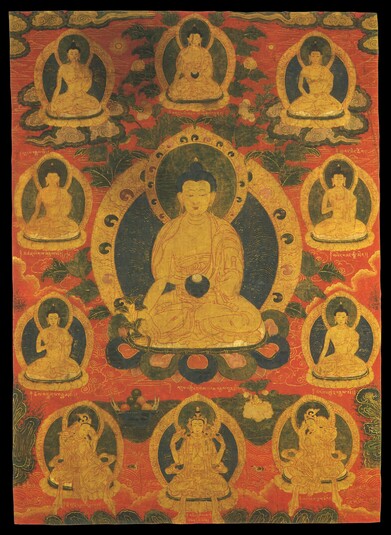
Item: Medicine Buddha
| Origin Location | Tibet |
|---|---|
| Date Range | 1700 - 1799 |
| Lineages | Gelug and Buddhist |
| Size | 57x40.50cm (22.44x15.94in) |
| Material | Ground Mineral Pigment, Fine Gold Line, Red Background on Cotton |
| Collection | Private |
Classification: Deity
Medicine Guru Buddha (Tibetan: sang gye men lha. Sanskrit: Bhaishajyaguru Vaiduryaprabha-raja): at the center is Medicine Buddha surrounded by the seven buddha brothers. Iconographically the Medicine Buddha has the typical appearance of a buddha but rather than golden skin he has a blue colour. Holding in the right hand a myrobalan medicinal fruit and in the left he supports a black begging bowl filled with healing nectar in the lap.
"...Bhagavan, Medicine Guru, with a body dark blue in colour, one face and two hands. The right hand is in the gesture of supreme generosity holding an arura [plant], left in meditative equipoise holding a bowl of nectar, with splendid glorious marks and examples. Wearing the three religious robes, the two feet seated in vajra posture." (Jamyang Kyentse Wangpo, 1820-1892).
At the top center is Shakyamuni Buddha. At the top left is Svaraghosharaja. At the top right is Ashokottamashri. At the middle left is Suparikirtitaraja. At the middle right is Suvarnabhadra Vimala. At the lower left is Dharmakirti Sagaraghosha. At the lower right is Abhijnaraja.
At the bottom center is Shadakshari Avalokiteshvara, also known as Lokeshvara. His special attribute is a white lotus flower and his special quality is compassion. "The Lord of the World with a body white in colour, one face and four hands. The first two hands are held at the heart with the palms together. The lower right holds a bead garland and the lower left a white lotus, the same ornaments and garments. Seated in the vajrasana [posture]." (Ngorchen Konchog Lhundrub, 1497-1557).
At the left side of Lokeshvara is Arya Manjushri in the appearance of a peaceful deity which is synonymous with bodhisattva appearance. His special attribute is the sword of wisdom and his special quality is wisdom. At the right side of Lokeshvara is Arya Vajrapani with the attribute of a vajra scepter and the special quality of strength.
Each of the figures in the painting are labelled with a name inscription written in gold lettering below. The central inscription reads: "The Medicine Guru Buddha clearing the sickness of the three times."
The red ground colour is appropriate for all deities that are classified in Buddhist Tantra as Power Deities, along with some peaceful deities, powerful teachers and important religious leaders. Red ground compositions often include gold outlining, or gold fill for the figures. Red ground paintings began to appear as a popular art form in the 17th century. The popularity can be traced to Central Tibet and the art patronage of the Great Fifth Dalai Lama, Ngagwang Lobzang Gyatso.
Identifying a painting as red ground and gold ground can sometimes be very difficult to recognize as later artists began to combine the two into single compositions. The ground of one painting might be red while all of the figures in the composition are gold filled. The artist might also employ the opposite technique, or other creative variations.
Jeff Watt 6-2000. [Revised 6-2006, 2-2019]
First published in Mystic Art of Ancient Tibet by Blanche Christine Olschak in collaboration with Geshe Thupten Wangyal. Page 64. George Allen & Unwin Ltd.: 1973. Shambhala, Boston & London, 1987. Tibetan Painting, The Jucker Collection by Hugo E. Kreijger. No. 5, page 38-39. Shambhala, Boston: 2001. (List of image plates).
Front of Painting
English Translation of Inscription: The Medicine Guru Buddha clearing the sickness of the three times.
Publication: Tibetan Painting (Jucker Collection)
Thematic Sets
Subject: Painting Atelier (Red Ground)
Collection of Jucker (Tibetan Art)
Painting Type: Gold Fill Paintings
Buddhist Deity: Medicine Buddha (Eight)
Painting Type: Gold Ground
Painting Type: Red Ground
Buddhist Deity: Medicine Buddha Main Page

